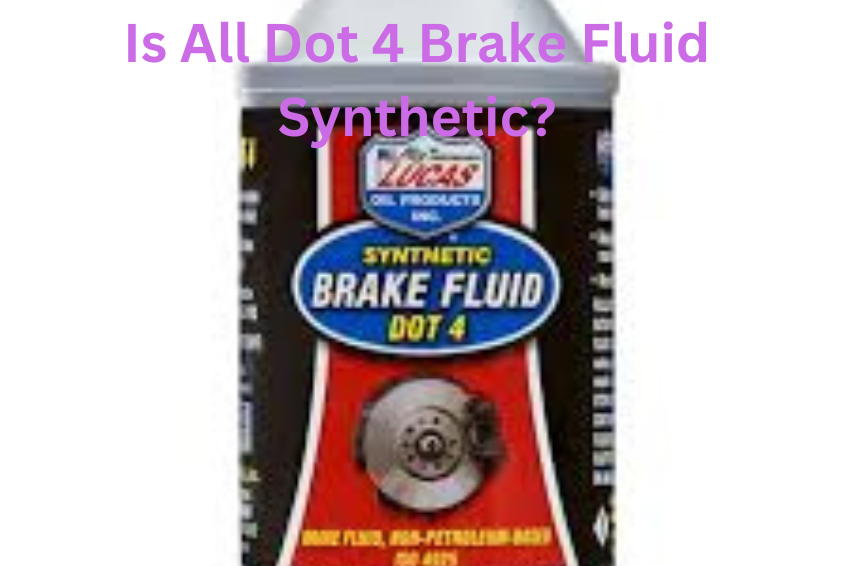All DOT 4 brake fluids are synthetic, meaning they use a man-made glycol-ether base rather than petroleum. While some manufacturers label DOT 4 as “synthetic” for marketing purposes, this doesn’t necessarily indicate a difference from standard DOT 4.
What Are The Benefits Of Using Synthetic DOT 4 Brake Fluid?
Synthetic DOT 4 brake fluid offers several advantages over conventional DOT 4 fluid, making it a popular choice for high-performance vehicles and drivers who demand exceptional braking performance.
Here are some of the key benefits:
Enhanced High-Temperature Performance:
One of the most significant advantages of synthetic DOT 4 fluid is its higher boiling point.
During heavy braking or on hot days, your brakes generate significant heat.
Conventional DOT 4 fluid can boil under extreme heat, leading to a spongy brake pedal and a dangerous loss of braking power, which is known as brake fade.
Synthetic DOT 4 boasts a higher boiling point, meaning it can withstand higher temperatures without boiling, ensuring consistent and reliable braking performance even under demanding conditions.
Improved Low-Temperature Fluidity:
Don’t let the cold weather compromise your safety.
Synthetic DOT 4 fluid maintains better low-temperature performance compared to conventional DOT 4.
This means it flows more easily in cold weather, ensuring your brakes react promptly and effectively even during winter mornings.
Extended Fluid Life:
Conventional DOT 4 fluid absorbs moisture from the air over time.
This absorbed water lowers the boiling point of the fluid, increasing the risk of brake fade.
Synthetic DOT 4 fluid may offer longer fluid life due to improved resistance to moisture absorption.
This translates to less frequent fluid changes, potentially saving you time and money in the long run.
Enhanced Corrosion Protection:
Your brake system is comprised of various metal components like calipers, pistons, and lines.
Synthetic DOT 4 fluid often contains special additives that provide enhanced corrosion protection.
This helps shield these vital components from rust and wear, promoting the overall longevity of your braking system.
While synthetic DOT 4 offers these advantages, it’s important to consider any potential drawbacks.
In some cases, synthetic DOT 4 fluid could be slightly more expensive compared to regular DOT 4.
Additionally, always consult your vehicle’s owner’s manual to ensure the recommended DOT specification for your car.
Using an incompatible fluid type can negatively impact your braking system.
Can I Mix DOT 4 and DOT 4 Synthetic Brake Fluid?
In most cases, yes, you can safely mix DOT 4 and DOT 4 synthetic brake fluid.
Both DOT 4 and DOT 4 synthetic fluids meet the same DOT 4 specification, they are chemically compatible and won’t cause any harm to your brake system.
So, mixing DOT 4 and DOT 4 synthetic fluid is generally safe.
You won’t experience any negative effects on your braking system due to incompatibility.
Both conventional DOT 4 and synthetic DOT 4 fluid share the same DOT 4 designation.
This indicates they adhere to the same standards and are formulated to work together without causing issues.
While mixing is safe, it’s important to consider the potential impact on performance.
If you specifically chose synthetic DOT 4 for its advantages like a higher boiling point, mixing it with conventional DOT 4 might dilute those benefits.
The overall boiling point of the mixture will be somewhere between the boiling points of the two individual fluids.
For optimal performance, especially if you prioritize the benefits of synthetic DOT 4 fluid, a full brake fluid flush and replacement is recommended.
This ensures your system is filled with fresh, high-performance synthetic fluid, maximizing its potential.
Remember, your vehicle’s owner’s manual is always the most reliable source for information on the recommended brake fluid type for your car.
Never use a DOT specification that is not specified in the manual, as this can lead to serious safety concerns.
